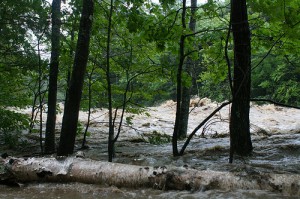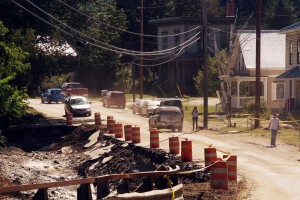How Do States Get FEMA Disaster Relief Money After Irene?
In the wake of Hurricane/Tropical Storm Irene, there’s been a lot of chatter about another big battle brewing in Congress: FEMA disaster relief funding. The agency’s been underfunded for years, to the point that it hasn’t been able to keep some promises dating back to 2008. Some long-term rebuilding projects have been put on hold as FEMA mobilizes to deal with damage from Irene. As New Hampshire, Vermont, and Massachusetts continue to examine the aftermath of the storm, they, along with other states, will likely have their hands out for federal money.
And all of this got StateImpact wondering…how do states go about getting FEMA funding, anyway?
We spoke with Jeanne Gallagher to find out. She’s the Recovery Director for FEMA Region 1, based in Boston, and she broke down for us how the process works:
- Step 1: The Pre-Disaster Emergency Delcaration: When something predictable, like a hurricane or tropical storm, looks like it might do damage beyond what the state can pay for, it’s the governor’s responsibility to send a letter to the President–by way of the regional FEMA office administrator. Gallagher says in this case, New Hampshire Governor John Lynch sent President Obama a letter last week, asking for a Presidential Emergency Declaration, “And in that emergency declaration, what he asked the president to do is grant him direct federal assistance, which would activate some federal teams, if he needed them, and emergency protective measures, which would reimburse th estate 75 percent for anything they spent protecting the public in advance of the storm.” Basically, Gallagher says, it’s kind of like state disaster insurance from the feds.
- Step 2: The FEMA Liaison: This can be combined with Step 1, and is part of pre-disaster

Brian Fisk / Flickr
New Hampshire will likely be among the states asking for FEMA aid due to Irene-related flooding.
planning. Besides asking for the Presidential Emergency Declaration, Lynch also asked FEMA to send up an agency liaison. “What the state liaison does is [act as] the conduit between FEMA and the state, and see[s] if there are any unmet needs in the state, or if there’s anything beyond the capability of state and local governments,” Gallagher says. In New Hampshire’s case, she says the state had to open emergency operations centers and deal with other logistical challenges related to crisis-management. Which led to…
- Step 3: The FEMA Incident Management Team: If a state (like New Hampshire, in this case) can’t handle the pre-crisis management in the run-up to a major storm, or its aftermath, the governor requests an Incident Management Team. They’re the feds who help the state manage emergency protective measures before and during the disaster itself. If a state needs chainsaw crews to clear debris, food for displaced residents, or other federal help, FEMA mobilizes more teams. Gallagher says New Hampshire got a ten-person Incident Management Team. In addition to mobilizing general assistance, they also watched where and how the state was deploying its resources (aka: spending money), and helped the state gather its preliminary receipts.
- Step 4: Preliminary Damage Assessment: Enter more FEMA teams. There are two major FEMA aid programs related to this step–public assistance, for things like roads and bridges, and individual/family assistance for homes. The relationship between public and private FEMA aid is complex, so for the sake of clarity, we’ll be focusing mainly on public assistance. Gallagher says for this step, state emergency officials and FEMA staffers will team up and go town to town, meeting with local emergency management officers and checking out the damage in person. “They’ll look at debris removal. How much is it going to cost to remove debris from public property? And emergency protective measures, how much is it going to cost with opening up all of their emergency operations centers, for bringing extra police and fire on to help with the event, and also permanent work…fixing the roofs and the bridges and the infrastructure.” The preliminary damage assessment is what FEMA’s working on in New Hampshire starting Thursday. The process typically takes about four or five days, depending on the damage. Once those rough numbers are compiled, state officials will work with FEMA to determine if the work is something the state can afford. If not, they’ll move on to Step 5.
- Step 5: Ask The President For A Major Disaster Declaration: Once the preliminary

Chip Allen / Getty Images
As states move toward formally requesting FEMA funding, officials will begin examining public infrastructure, like this damaged road in Vermont.
reports trickle in, usually over the course of that first week after a major storm, the state and FEMA sit down and crunch the numbers. They come up with a rough dollar amount that the state just can’t pay for disaster relief. Then they’ll ask the President to make a Major Disaster Declaration. That authorizes FEMA to start collecting claims from communities, and (theoretically) loosens up disaster relief fund money. This step usually happens a couple of weeks after the storm.
- Step 6: First Local Applications: Once the Major Disaster Declaration comes down, damaged communities submit what amounts to a mini-application to participate in the FEMA disaster relief program. That lets them in on Step 7.
- Step 7: Briefings: FEMA and state staffers will hold meetings for city and town officials, and explain what’s eligible for federal assistance.
- Step 8: Request Reimbursement: Since they know what they’re looking for, the state, cities and towns can tally-up the Irene-related damages they think are eligible. They’ll file their application for aid with FEMA. FEMA will then look through the application, and tell them what they’re actually eligible to be reimbursed for.
- Step 9: Last Round Of Paperwork: And now that they know exactly what will be covered, the state, cities, and towns can submit their receipts to FEMA for reimbursement.
All told, Gallagher says working through these nine steps after a disaster takes around two months. So if your state was hit by Irene, you’ll probably see the final FEMA aid figure around November.
